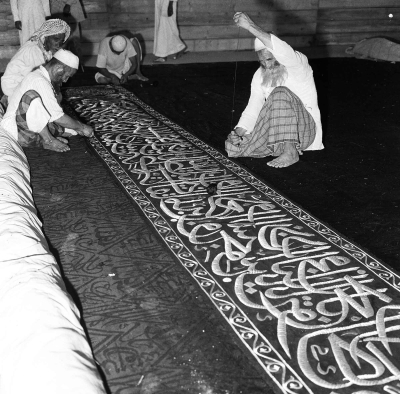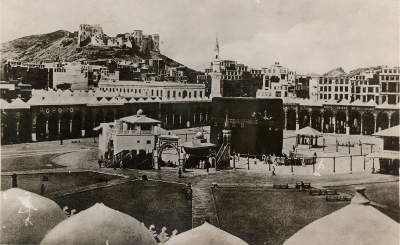
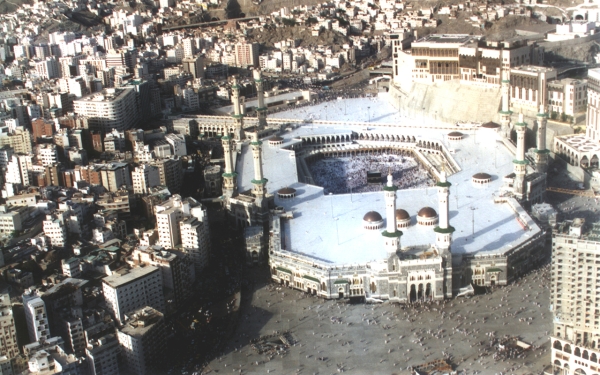
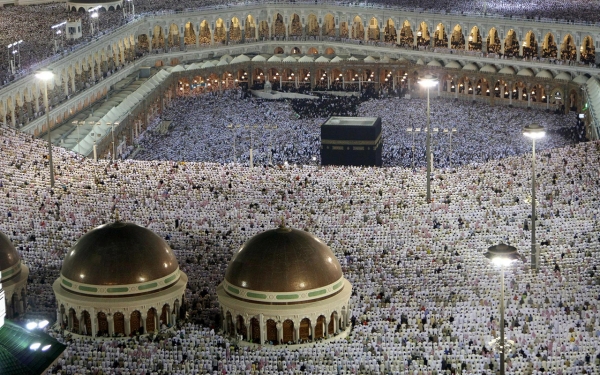
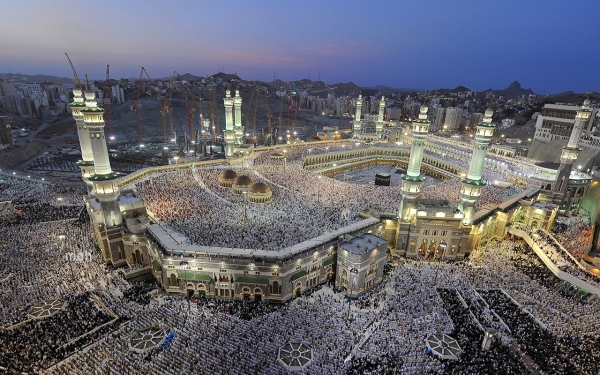
The Second Saudi Expansion of the Grand Mosque is the second increase in the area and structure of the Grand Mosque during the Saudi era. It was directed by King Fahd Bin Abdulaziz Al Saud on the western side of the Grand Mosque. The foundation stone was laid in 1988, and the expansion began in the area known as the Small Market, which extended between King Abdulaziz Gate and Umrah Gate. The project components consisted of a ground floor, an upper floor, and a basement.
Elements of the Second Saudi Expansion of the Grand Mosque
The Second Expansion includes King Fahd Gate, which is considered one of the largest gates of the Grand Mosque, in addition to eighteen entrances. The expansion also features two complexes containing fifty-six electric escalators. The expansion building is topped with two minarets, each ninety-six m high, and three domes covered with exquisite ceramic tiles. There are 1,453 columns clad in marble, of which 1,120 have bases and floor air conditioning vents.
In 1990, the Second Saudi Expansion introduced the largest courtyards to the Grand Mosque. These courtyards were equipped with lighting and carpeting for prayer, and a cold and heat-resistant marble was utilized in their construction. The total area of these courtyards was eighty-eight thousand m.
Renovations of the Second Saudi Expansion of the Grand Mosque
In addition to expanding the area and construction of the Grand Mosque, the Second Saudi Expansion of the Grand Mosque included several renovations and reforms. Among the most significant are the expansion of the Safa area, increasing the space of Marwa, the construction of the al-Raqqubah Bridge leading directly to the rooftop of the Grand Mosque, and the renovation of the covering of Maqam Ibrahim peace be upon him (PBUH).
The King Fahd expansion works also included renovations to al-Kaaba al-Musharrafa. The first of these included repairing the external joints, sealing gaps, treating the apparent peelings on its stones by removing the dirt, stones, and sediments between the rocks, followed by cleaning and drying them with compressed air, preparing them for full restoration, and replacing several elements of the ceilings, walls, and floors.
Construction of the Second Saudi Expansion of the Grand Mosque
The construction of the Second Saudi Expansion began with the basement after establishing fire systems, water, ventilation networks, lighting, and air conditioning. Its area reached eighteen thousand m, and its height reached 4.30 m.
During its construction, the expansion areas were divided into fifteen independent and harmonious units in architectural and structural aspects. All the ground units were roofed except for the space parallel to the three domes that characterize the heart of the expansion. The total area of the ground floor reached twenty thousand m, while its height reached 9.80 m.
The upper floor in the Second Saudi Expansion of the Grand Mosque
The construction of the upper floor of the Second Saudi Expansion was designed to match the ground floor in terms of design and construction materials. Three equal and adjacent domes were placed on its ceiling. The floors of the expansion and its rooftop were paved with marble that reflected sunlight. The corridors of the Second Expansion were connected to the First Expansion through wide entrances that led to the Mataf courtyard and the southern and northern sides of the Grand Mosque.
Area of the Second Saudi Expansion of the Grand Mosque
The total area of the Second Saudi Expansion of the Grand Mosque reached eighty-seven thousand m, including all floors and the rooftop. Consequently, the total area of the entire mosque increased to 366,168 m, up from what was previously no more than 160,168 m. This means the mosque's area more than doubled compared to its size after the First Saudi Expansion. After the completion of the Second Saudi Expansion, the capacity of the Grand Mosque reached 820,000 worshipers across all its corridors, its rooftop, and its courtyards during regular times. During peak periods, this capacity increases to more than one million worshipers.
Features of the Second Saudi Expansion of the Grand Mosque
The Second Saudi Expansion of the Grand Mosque was characterized by its artistic decorations and engravings on the domes, corridors, ceilings, walls, doors, windows, and arches. Additionally, the design included crystal pieces, mashrabiyas, lanterns, chandeliers, and column capitals. These embellishments were crafted using materials such as gold, crystal, glass, colored granite, man-made stone, ceramics, plaster, yellow aluminum, Moroccan cedar wood, and teak wood.
Related quizzes
